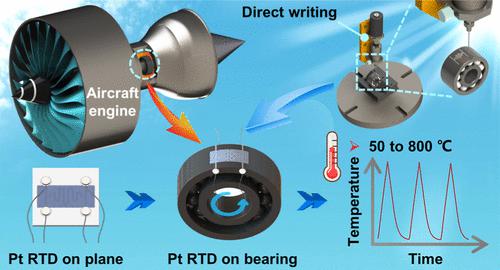当前位置:
X-MOL 学术
›
ACS Appl. Mater. Interfaces
›
论文详情
Our official English website, www.x-mol.net, welcomes your
feedback! (Note: you will need to create a separate account there.)
Thin-Film Platinum Resistance Temperature Detector with a SiCN/Yttria-Stabilized Zirconia Protective Layer by Direct Ink Writing for High-Temperature Applications
ACS Applied Materials & Interfaces ( IF 8.3 ) Pub Date : 2022-12-27 , DOI: 10.1021/acsami.2c18611 Yingjun Zeng 1, 2 , Guochun Chen 1, 2 , Chao Wu 1, 2 , Xiaochuan Pan 1, 2 , Fan Lin 1, 2 , Lida Xu 1, 2 , Fuxin Zhao 1, 2 , Yingping He 1, 2 , Gonghan He 1, 2 , Qinnan Chen 1, 2 , Daoheng Sun 1, 2 , Zhenyin Hai 1, 2
ACS Applied Materials & Interfaces ( IF 8.3 ) Pub Date : 2022-12-27 , DOI: 10.1021/acsami.2c18611 Yingjun Zeng 1, 2 , Guochun Chen 1, 2 , Chao Wu 1, 2 , Xiaochuan Pan 1, 2 , Fan Lin 1, 2 , Lida Xu 1, 2 , Fuxin Zhao 1, 2 , Yingping He 1, 2 , Gonghan He 1, 2 , Qinnan Chen 1, 2 , Daoheng Sun 1, 2 , Zhenyin Hai 1, 2
Affiliation

|
In situ temperature monitoring of curved high-temperature components in extreme environments is challenging for a variety of applications in fields such as aero engines and gas turbines. Recently, extrusion-based direct ink writing (DIW) has been utilized to fabricate platinum (Pt) resistance temperature detectors (RTDs). However, the current Pt RTD prepared by DIW technology suffers from a limited temperature range and poor high-temperature stability. Here, DIW technology and yttria-stabilized zirconia (YSZ)-modified precursor ceramic film packaging have been used to build a Pt RTD with high-temperature resistance, small disturbance, and high stability. The results indicate that the protective layer formed by the liquid phase anchors the Pt particles and reduces the agglomeration and volatilization of the Pt sensitive layer at high temperature. Attributed to the SiCN/YSZ protective layer, the temperature resistance curve of the Pt RTD in the range of 50–800 °C has little deviation from the fitting curve, and the fitting correlation coefficient is above 0.9999. Interestingly, the Pt RTD also has high repeatability and stability. The high temperature resistance drift rate is only 0.05%/h after 100 h of long-term testing at 800 °C and can withstand butane flame up to ∼1300 °C without damage. Moreover, the Pt RTD can be conformally deposited on the outer ring of aerospace bearings by DIW technology and then realize on-site, nondestructive, and real-time monitoring of bearing temperature. The fabricated Pt RTD shows great potential for high-temperature applications, and the novel technology proposed provides a feasible pathway for temperature monitoring of aeroengine internal curved hot-end components.
中文翻译:

具有 SiCN/氧化钇稳定氧化锆保护层的薄膜铂电阻温度检测器,用于高温应用的直接墨水书写
极端环境下弯曲高温部件的原位温度监测对于航空发动机和燃气轮机等领域的各种应用来说具有挑战性。最近,基于挤压的直接墨水书写 (DIW) 已被用于制造铂 (Pt) 电阻温度检测器 (RTD)。然而,目前采用DIW技术制备的Pt RTD存在温度范围有限、高温稳定性差等问题。在这里,DIW 技术和氧化钇稳定的氧化锆 (YSZ) 改性前体陶瓷薄膜封装已被用于构建具有耐高温、干扰小和高稳定性的 Pt RTD。结果表明,液相形成的保护层锚定了Pt颗粒,减少了Pt敏感层在高温下的团聚和挥发。由于SiCN/YSZ保护层,Pt RTD在50~800℃范围内的耐温曲线与拟合曲线偏差很小,拟合相关系数在0.9999以上。有趣的是,Pt RTD 还具有很高的重复性和稳定性。在800℃下长期测试100小时后,耐高温漂移率仅为0.05%/h,可承受高达~1300℃的丁烷火焰而不损坏。此外,铂热电阻可以通过DIW技术共形沉积在航空轴承外圈,实现轴承温度的现场、无损、实时监测。制造的 Pt RTD 显示出高温应用的巨大潜力,
更新日期:2022-12-27
中文翻译:

具有 SiCN/氧化钇稳定氧化锆保护层的薄膜铂电阻温度检测器,用于高温应用的直接墨水书写
极端环境下弯曲高温部件的原位温度监测对于航空发动机和燃气轮机等领域的各种应用来说具有挑战性。最近,基于挤压的直接墨水书写 (DIW) 已被用于制造铂 (Pt) 电阻温度检测器 (RTD)。然而,目前采用DIW技术制备的Pt RTD存在温度范围有限、高温稳定性差等问题。在这里,DIW 技术和氧化钇稳定的氧化锆 (YSZ) 改性前体陶瓷薄膜封装已被用于构建具有耐高温、干扰小和高稳定性的 Pt RTD。结果表明,液相形成的保护层锚定了Pt颗粒,减少了Pt敏感层在高温下的团聚和挥发。由于SiCN/YSZ保护层,Pt RTD在50~800℃范围内的耐温曲线与拟合曲线偏差很小,拟合相关系数在0.9999以上。有趣的是,Pt RTD 还具有很高的重复性和稳定性。在800℃下长期测试100小时后,耐高温漂移率仅为0.05%/h,可承受高达~1300℃的丁烷火焰而不损坏。此外,铂热电阻可以通过DIW技术共形沉积在航空轴承外圈,实现轴承温度的现场、无损、实时监测。制造的 Pt RTD 显示出高温应用的巨大潜力,

































 京公网安备 11010802027423号
京公网安备 11010802027423号